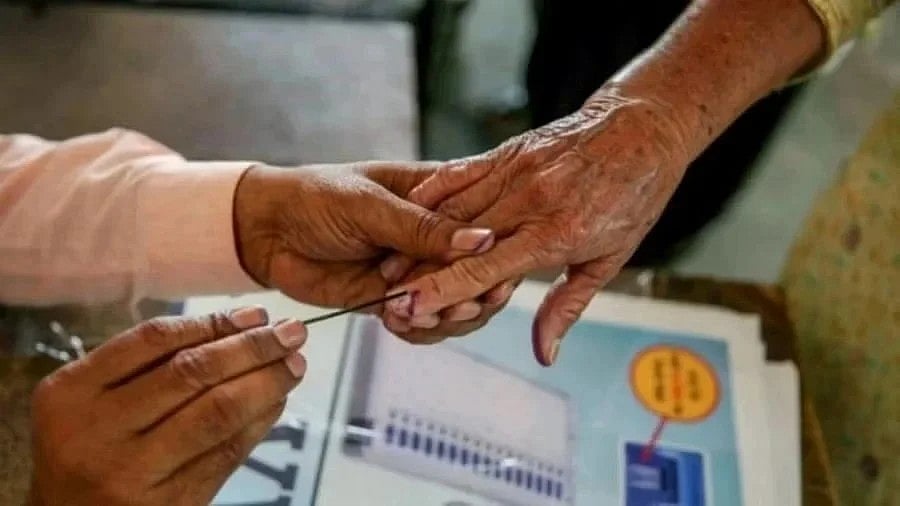
A representative image of a person casting vote.
Credit: PTI Photo
For four decades and more that he has been here, Ram Vilas has done only one thing: cook and feed his comrades. In the division of labor, that was the task assigned to him at the Community Party of India district office at Begusarai, once called the Leningrad of India for influence and deep penetration of Marxist politics in this district in north-central Bihar.
Some 14 km south of the town, on the banks of the Ganga at the Simaria Ghat, tents have been pitched for the holy months of Kartik. Thousands of believers flock here to seek deliverance. Umesh Pan, from the Extremely Backward Caste weaver community, has mounted a tractor troll to return home after taking a dip in the holy river.
“There is continuity. And it will remain like that,” he says on being asked how he sees the outcome of the upcoming polls.
In a way, Begusarai epitomizes India’s complex caste matrix, its paradoxes, diversity, and also the failure of the Indian Marxists to factor in caste in the dialectical class conflict. The story goes like this:
The political leadership in Bihar after independence remained with the upper-caste, land-owning communities, including Brahmins and Bhumihar. New political faultlines began to emerge a decade or so after Independence when landless peasantry and intermediary castes sought land reforms.
Interestingly, the leadership of the movement in north Bihar came from the same upper-caste gentry that, as a social group, was also the repository of large and medium-sized landholdings. In Bagusarai, the penetration of the Left ideology was also hastened by the setting up of an oil refinery at Barauni, 14 km on from the district headquarters, and the subsequent growth of other auxiliary industrial units.
The first CM of Bihar, Shri Krishna Singh, was a Bhumihar. So was Chandrashekhar Singh, the topmost CPI leader in the district, whose statue now adorns the party office. His village, Bihat, is right at the banks of the Ganga, and is also home to former JNU Left student union leader Kanhaiya Kumar, who has now joined Congress.
The decisive shift in Bihar identity politics was triggered with the implementation of the Mandal Commission report in 1990 and the subsequent rise of political leadership from the intermediary castes and lower caste groups, with the emergence of Lalu Yadav, Nitish Kumar, and Ram Vilas Paswan.
When the CPI as a party complemented the social justice politics of the Janata Dal, as in 1991, their alliance won more than 40 out of 54 seats in undivided Bihar. 9 out of these were won by CPI alone.
Allies in politics are also competitors, especially if they were to draw mass base from the same set of people. The drift of the castes and communities that were once at the core of CPI’s class struggle, towards parties enunciating social, political, and economic empowerment was but obvious. The new paradigm offered both representation and kinship with the leadership, unlike the Left, where the leadership was predominantly upper caste.
Ironically, the rise of RJD and other Mandal parties in the heartland states has been more at the cost of their “natural allies”, the Left.
But the BJP, on the other hand, was willing to factor in caste dynamics in north India’s political landscape and negotiate with the social groups. After Mandal rupture and marginalization of the Congress, it became the repository of upper caste votes.
The saffron outfit waited for its turn, and when the larger Mandal block showed signs of fracture with smaller OBC groups challenging the hegemony of Yadavs, it moved in to stitch its own social coalition of with minor OBCs led by Nitish Kumar to capture power in 2005.
Former state assembly speaker and MP Bhola Singh’s political trajectory gives a fair idea of the metamorphosis of the north-Bihar political scene and how various social groups negotiated their positions.
Singh, from the upper-caste Bhumihar community, started his political career with CPI and became an MLA in 1972. He later joined the Congress to become a minister in the state. With the fall of Congress, he tried his luck with the RJD for a brief period and then finally down in the BJP to win the 2014 LS polls on the party symbol.
After his passing away, Begusarai is now represented in the LS by Union Minister Giriraj Singh, who comes from the same community as Bhola Singh.
The overlap of the political support base of the INDIA bloc constituent that seeks to represent a similar constituency is evident in the 2025 elections as well. Out of the seven seats in the district, 2 are being contested by CPI, one by CPM, and the rest by RJD and Congress. In one seat, there is a friendly fight between Congress and CPI.
“We have had to stitch a social coalition with the other parties to fight the BJP, the bigger enemy,” says Shambu Deva, local CPI leader.
Now BJP is the new class enemy. Before 1990, it was the Congress. Be it the Left, the Right, or the Center, politics is the art of the possible. The one who can manage the contradictions has a larger probability of assuming power. CPI in north Bihar could do that with finesse till the early nineties. And they got the results.